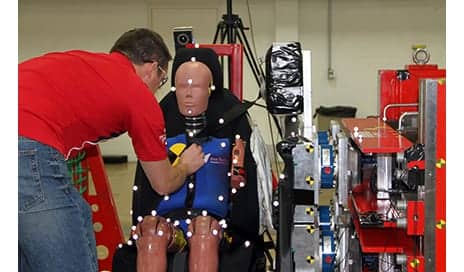
A researcher from The Ohio State University Wexner Medical Center prepares to perform crash tests on a smaller, more fragile dummy resembling an elderly driver at a test site. (Photo courtesy of The Ohio State University Wexner Medical Center)
Although seat belts can save lives, they may not provide optimal safety for everyone—especially elderly drivers. A team of researchers from The Ohio State University Wexner Medical Center is conducting crash tests to help improve seat belt safety and reduce injuries among that age group.
The team, led by John Bolte, associate professor of health and rehabilitation sciences at The Ohio State University College of Medicine and director of Ohio State’s Injury Biomechanics Research Center, is analyzing differences in injuries sustained in side impact car crashes involving drivers age 65 and above as a way to help improve seat belt designs to better protect this population.
“When seat belts were first designed about 4 decades ago, safety dummies tested in car crash simulations resembled the average-size male driver of 40 years old and weighing approximately 170 lbs,” says Bolte, also the study’s principal investigator, in a media release from The Ohio State University Wexner Medical Center.
In their crash test simulations, the researchers are using smaller crash test dummies that are a better representation of a more fragile older person. Their analysis will measure not only impact, but also the dummy’s position and the properties of the upper body to better predict the appropriate protection for the elderly driver, per the release.
“Age isn’t the best predictor of how someone responds to injury. We need to move the field away from age and into something more scientifically based, such as looking at properties of the thorax or upper body to better predict how much impact is associated with certain injuries,” Bolte adds.
Even improperly fitted seat belts can save lives, but they can also cause injury, such as fractured ribs or a broken pelvis. These types of injuries may not be critical for young drivers. However, they could be life threatening for elderly drivers.
“We’re hopeful our data will assist with safety design modifications to better protect the older, more vulnerable drivers,” Bolte states in the release.
[Source: The Ohio State University Wexner Medical Center]


